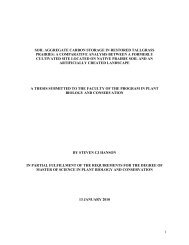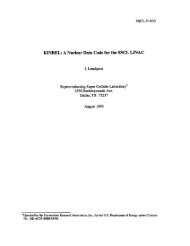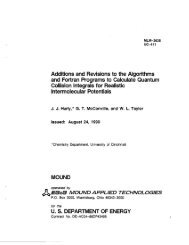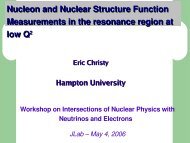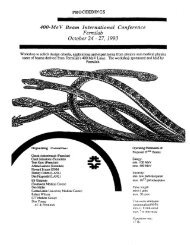Workbook
Workbook
Workbook
You also want an ePaper? Increase the reach of your titles
YUMPU automatically turns print PDFs into web optimized ePapers that Google loves.
80<br />
the third (Level 2) is a software filter implemented on a farm of 48 VAX. Station<br />
4000 computers with full event information available. A supplementary<br />
Level 1.5 trigger refines the Level 1 muon trigger.<br />
Initial running concentrated on commissioning the apparatus and<br />
understanding the effects of the Main Ring beam which passes through the<br />
calorimeter 2m above the Tevatron beam. First collisions were observed on<br />
May 12, 1992 and the data run started after a brief shutdown in August. Over<br />
the whole of Run la, DO accumulated 15pb- 1 of collider data including special<br />
and calibration data runs. The overall ratio of beam data recorded to beam<br />
available was about 70%, with the main loss coming from the veto imposed to<br />
stop triggering during Main Ring injection and transition and while Main<br />
Ring protons pass through the detector. Data were taken at a rate ofabout 2 Hz<br />
and reconstructed at the same rate on a multi-processor UNIX farm.<br />
DO is now taking data in Run lb. The detector has been improved for the<br />
higher luminosities compared with Run la by the addition of a cosmic ray<br />
shield for the muon system and hardware Level 1.5 trigger for electrons<br />
capable of performing both threshold and simple isolation cuts. The<br />
bandwidth to tape was approximately doubled and now is 1.6 MHz which<br />
corresponds to an event rate of 3Hz.<br />
Current la and Ib physics analyses at DO are organized into five groups.<br />
The Top Quark Group was able to set a mass limit of mt > 131 GeV using<br />
Run la data. With the larger statistics available from Run Ib, we reported<br />
observation of the top quark, with a mass of about 200 GeV, in February 1995.<br />
This is a major accomplishment in understanding the Standard Model. We<br />
will refine our measurements of the properties and decays of the top quark as<br />
we continue to take data in Run lb.<br />
The QCD Group has presented cross sections for inclusive jets in the<br />
central and forward regions and differential cross sections for dijet<br />
production. The dijet angular distributions have been measured, and photon<br />
cross sections and angular distributions presented. Many new analyses have<br />
extended the study of QCD at the Tevatron Collider into new regimes: the<br />
observation of rapidity gaps between forward and backward jets is a signal for<br />
colorless exchange, e.g. pomerons; the decorrelation in azimuthal angle<br />
between forward and backward jets allows tests of resummation in mixedscale<br />
problems; measurement of energy flow around jets allows the color<br />
coherence of gluon emission to be probed.<br />
The Electroweak Group focuses on the production and decay of Wand Z<br />
bosons. Results presented from Run Ia data include the W mass, Wand Z<br />
production cross sections, and PT distributions. The production of dibosons<br />
(Wy, Zy, WW, WZ) through trilinear couplings, a test of the Standard Model,<br />
has been studied with Run Ia data. DO is also using vector-boson-plus-jet<br />
events as a QCD laboratory: the strong coupling constant as has been<br />
measured from W+jet events and color coherence effects can be studied here<br />
too.



